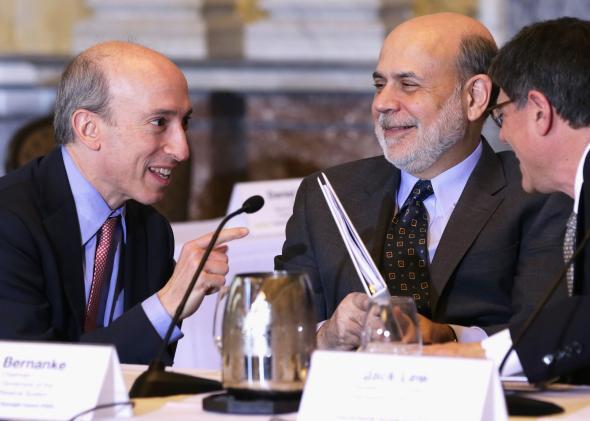With the Volcker Rule poised to be finalized in what looks like a fairly tough version, it’s perhaps time to step back and offer a bit of an overview of what this role is and what you need to know about it.
1. The rule’s intent is to ban “proprietary trading” by banks that also have insured deposits: That’s the plain English concept that Paul Volcker sold Barack Obama on, and that first legislators and now regulators have been trying to turn into legal language. When you put money into a bank account, the bank is going to want to do something with it. The traditional thing to do was to lend it out at a higher rate of interest than you pay to depositors. But other things are possible, including trading. The idea of the Volcker Rule is that banks shouldn’t be using that money to trade derivatives.
2. It’s not at all clear that proprietary trading is an unusually risky undertaking: It’s absolutely true that a complicated derivatives deal could blow up in the face of traders, causing huge losses and risking bank failure and economic devastation. On the other hand, it’s also totally possible for ordinary lending to blow up in this exact same way. And during the 2008 financial crisis, it looks like what went wrong was mostly just bad lending not some kind of particular problem with proprietary trading.
3. It’s not at all clear that there’s any social loss in banning proprietary trading: On the other hand, the banks’ crocodile tears that they need a free hand to engage in trading in order to hedge risk doesn’t seem very persuasive. For starters, the rule-as-written does allow for a fair amount of hedging. It simply tries to draw this exemption reasonably narrowly. More to the point, if we learned in 2008 that you don’t need exotic trading products to drive your bank underwater during bad times we also learned that banks on a lending binge do not, in fact, hedge their risks with derivatives to avert failure.
4. The Volcker Rule is divide-and-conquer bank regulation: If you want to, in some sense, “shrink” the financial sector, you have a problem. The financial sector doesn’t want to shrink! And no other sector wants to spend a lot of time lobbying for it to shrink. What you need to do is turn elements of finance against each other. The Volcker Rule harms some banks, by preventing them from doing something profitable, but plenty of banks never did much or any trading. So those banks are happy to see competitors handicapped. The Glass-Steagall Act had this exact same property, it was a somewhat arbitrary rule that nonetheless had a role to play in the political economy of financial repression.
5. There’s an uneven legal playing field once the rule is written: The way the regulatory state works is that first congress writes a law, then regulators write a detailed rule, and then people who think the rule is unfair to them get to sue and get judges to throw the rule out. If you’re some kind of bank regulation junky who thinks the rule is too kind to banks, you do not get to sue and get judges to make the rule stricter. This is one of a dozen of reasons why “judicial nominations” matter for more reasons than “the Supreme Court rules on abortion rights.” There’s an ongoing fight in Congress about appointees to the D.C. Circuit Court which is rich in regulatory implications, of which the Volcker Rule battle is one.
